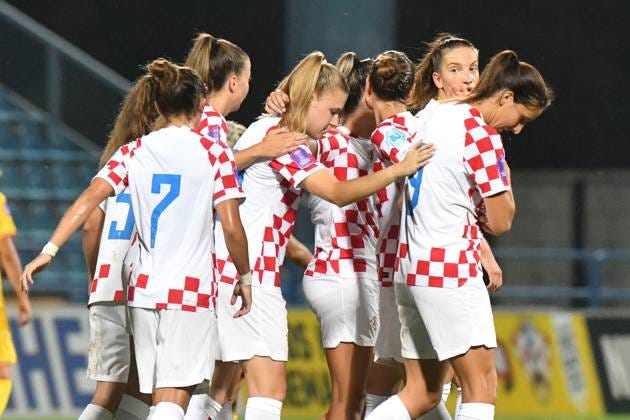Road to 2027: Croatia's puzzling deficit compared to it's men's team
Croatia's men have been at the deep end of major tournaments, their women haven't even been close to a tournament full stop. WFC set out to find out why and if it's going to change...
There are few nations in the sport at the minute where the difference in success between men’s and women’s teams is as stark as Croatia’s.
Perhaps it’s a case of the men’s team overperforming? Given after all this is a nation of just under four million people, and its men’s domestic league ranks only 21st in UEFA’s coefficient list.
Yet in 2018, they took part in the World Cup final against France, and in Qatar in 2022 finished third, an huge success for a country the size of Croatia.
They are ranked 10th currently by FIFA, but were as high as third back in 1999, and have produced top class talents such as Luka Modrić, Ivan Perišić, Ivan Rakitić and many more.
Meanwhile, the nation’s women’s team have never even been to a major tournament, and have rarely even come close.
“The development of women’s football in Croatia is still in its earliest stages…”
They are ranked 58th in the world, and when qualifying for the 2019 World Cup won none of their eight games. For the 2023 tournament, they won three out of 10, but weren’t near to making it to Australia and New Zealand.
In the European Championships, it doesn’t get a lot better, with just six wins in the past four qualification campaigns combined.
Unlike Real Madrid’s Modrić, players have rarely made into Europe’s big leagues, with most of the current squad in either Switzerland, Austria or Turkey, while seven of them still playing domestically in Croatia.
Their most capped player, Iva Landeka, made it to Sweden with FC Rosengård and France with Montpellier, while their top scorer has just 20 goals across 13 years, Maja Joščak between 2006 and 2019.
Whether it be 2027 or beyond, the country is at least keen to change their current situation on the women’s side of the game, but the perception from within is also that is not that far behind, they are just starting later than other nations.

Božidar Miletić, former head coach of the senior national team, is now Women’s Football Coordinator for the Croatian Football Federation, as well as being head coach of various youth teams, and states “When comparing women’s and men’s football in Croatia, I don’t know if the formulation that the ‘women’s game has been so far behind’ is necessarily correct.”
Miletić, who joined the women’s football department back in 2015, adds “The development of women’s football in Croatia is still in its earliest stages, while men’s football has always been popular and there’s this big tradition behind it.
“Just looking at the number of boys playing football in Croatia versus the number of girls and comparing that to the general populations, as well as comparing the number of men’s and women’s clubs and the quality of coaches in men’s and women’s football is enough to tell you how different the state of these two disciplines is. Our general conclusion is that we have an ideal development system within men’s football and that we need to implement it for women’s football, too.
“This process will naturally take years and we’ll need a lot of patience and hard work to get there, but the progress has been clear and obvious to the people that follow women’s football. A few years ago, we couldn’t even imagine that our U17 and U19 national teams would be in the Elite Qualifying Rounds, and yet we’ve now reached them for three consecutive years. It is true that we still can’t compete with the bigger teams in the Elite Rounds, but we’re on the cusp of getting there.”
Check out over 100 more unique stories in WFC’s Premium section, available for just £45 for 12 months, paid in one go, or a £6 a month rolling subscription.
All subscriptions come with a 7-day free trial to allow you to explore our full archive.
Plus, guarantee you everything that is to come over the next 12 months…
Or check out previous Road to 2027 features…
He’s right too, and the progress of the national youth teams is something which gives them hope, and it’s a key area of development given these are the players now getting access to the new developments taking place within the HNS, and therefore may make up a stronger senior team in years to come.
Both their U19s and U17s have won their groups in League B of the first round of qualifiers for their respective European Championships this summer, and will enter League A for the final round in March and April.
While qualification for the final tournament will be almost impossible, they want to stay in League A, as last year both youth sides got relegated back to League B, with the U19s not getting a point, and the U17s managing one against Belgium.
“I think right now we’re between League B and League A,” says Miletić, and the U17s winning their group with three wins from three, 19 goals and none conceded backs up the point, “we’ve outgrown the lowest levels of women’s football in Europe, but we’re still not at that top level, we sit somewhere between those two extremes.
“We recently scored our first goals in the Elite Qualifying Rounds, which was a big step forward, though it might look simple to those who are not within the women’s football system and aren’t aware of how hard this is.”
Keep reading with a 7-day free trial
Subscribe to Women's Football Chronicles to keep reading this post and get 7 days of free access to the full post archives.







